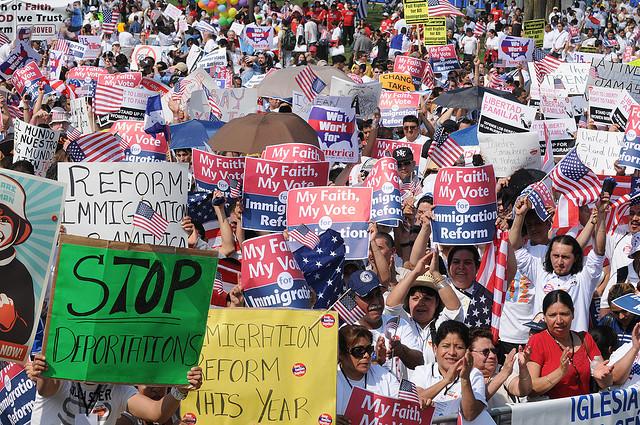According to a report from New American Economy, immigrant residents contributed $3.4 billion to Dane County’s GDP in 2016. That is, 8.7 percent of Dane County residents are contributing their share, 8.7 percent, of the county’s total value of goods and services.
The report also found that immigrants contribute to the labor force, representing 10.7 percent of the county’s working-age population and 17.1 percent of the county’s STEM workers. Additionally, the research suggests that because of the population increase that immigrants contribute to and the entrepreneurship they pursue, immigrants have helped create or preserve over 2,000 local manufacturing jobs that would have otherwise vanished or moved elsewhere.
In light of these findings, two sets of questions come to mind: Are these measures of economic contribution — and in turn, economic growth — attributable to Madison’s commitment to welcoming and protecting immigrants, regardless of their documentation status, re-affirming Madison’s commitment to be a sanctuary city? If not, what are the dangers of assuming economic growth and immigration are related?
The second set of questions deals with the nature of Dane County’s immigrants. If economic growth is a result of immigration, are there still problems with classism in the immigration system itself? The study found the top occupation for immigrants in Dane County was postsecondary teachers. Does the immigration system favor academics?
Let’s break down the arguments.
By including undocumented students, PEOPLE program takes step forward for educational accessibility
The first set of questions assumes two things. First, they assume that documented immigrants and undocumented immigrants are equally protectable and valuable to the economy. The NAE does have something to say about undocumented immigrants: they take jobs that few Americans are interested in pursuing, such as agricultural work, grounds maintenance and food prep/service work. But that argument. along with the general statistics showing immigrants contribute to economic growth, does very little work to answer the question of whether immigrants, no matter how they got here, should be protected.
Both sides of the aisle would likely agree the country greatly benefits from the labor of its 8 million undocumented immigrant workforce. The Pew Research Center estimates that the United States is home to about 11.1 million undocumented immigrants — certainly, all their spending and working help to fuel the economy. The problem is this: when it comes to questions about whether to protect those who followed the law as opposed to those who broke the law, it is always in the community’s best interest to favor those who follow the law. By protecting both types of immigrants, a community dismisses its respect for the law and disincentivizes others to abide by it.
Walker cannot claim recovery from Great Recession when racial disparities run rampant
The second assumption made in the first set of questions is that the New American Economy’s primary motivation is to share information about immigration and its effects on the economy. The researchers are open from the very beginning that they want to reframe the immigration debate to focus on entrepreneurial immigrants and their role in stimulating the economy. Intermixed in the study are personal stories of real-life immigrants living and working in Madison.
One could easily frame the argument for the other side, as does a similar, but a lengthier study published by the Federation for American Immigration Reform in 2017. This study looked at the astronomical burdens placed on taxpayers to fund federal programs designed around immigrants, regardless of their documentation status.
A truly robust study does not have a narrative — it does not have a goal outside of presenting information.
The second set of questions assumes that classism is good when it is used to promote the intrinsic good of immigration, but bad when it favors a small portion of highly educated immigrants.
Interestingly, the NAE also published a report suggesting the government ought to favor highly-educated and STEM-related immigrants, but it is perfectly consistent with their original frame in that immigration is important for economic growth.
What follows is that a society, like Dane County, home of a world-renowned research institution, will tend to have immigrants who are mostly taking postsecondary teaching jobs. To measure economic growth, one must look at dollars and the professions that have the most of it, namely business-owners and STEM researchers. To combat the classism within the immigration system, someone has to disincentivize STEM and research jobs and incentivize low-skilled labored jobs.
While this is a very plausible solution to this systemic problem, it merely fixes the distribution of who is in which class. The immigration system will always appear to be classist, and it is a bullet that groups like NAE have to bite if they want to promote the idea that immigrants contribute wealth to the economy.
Madison City Council’s ICE condemnation ignores protocol, undermines duty to legal immigrants
The reasons for more lax immigration policies are easily supported by the economic growth argument, but the immigrants who followed the lawful procedure to enter the country need a system that sets them above their undocumented counterparts. Additionally, by having the freedom to work jobs that allow for the accumulation and spending of wealth, immigration will always be a positive for Dane County’s economy.
Lianna Schwalenberg ([email protected]) is a fifth-year senior majoring in communication arts and philosophy.














